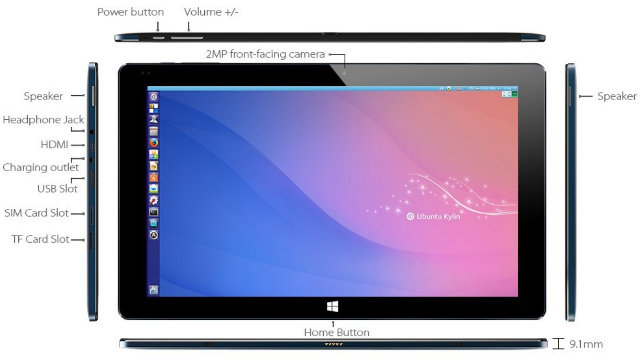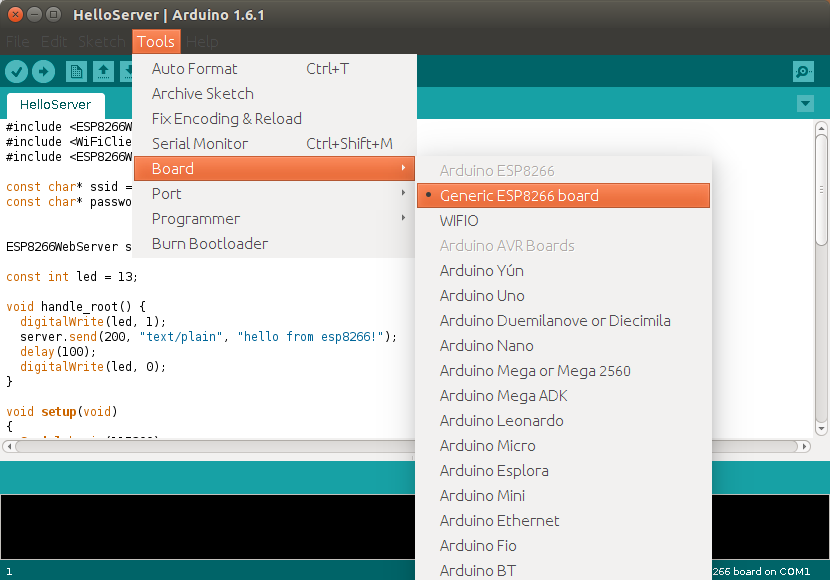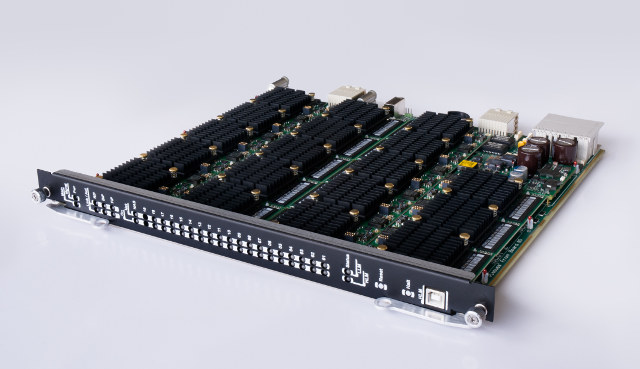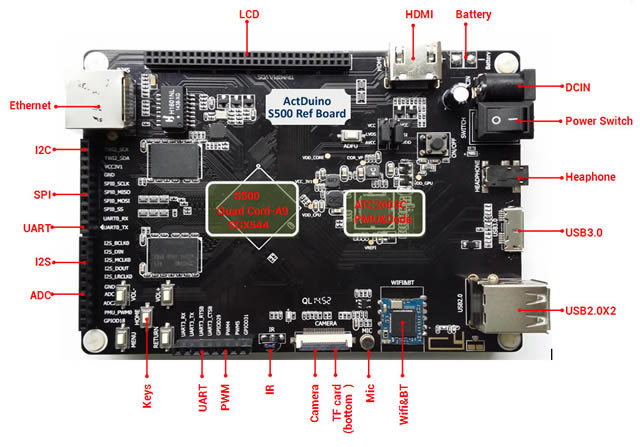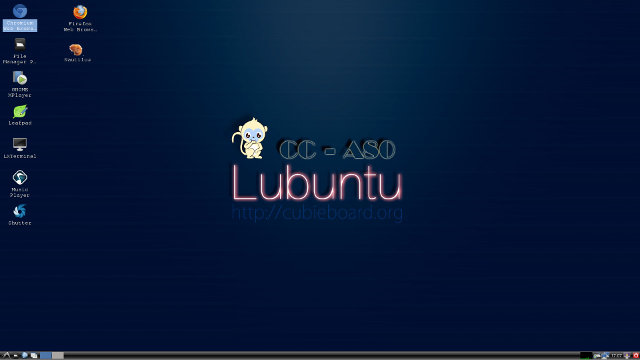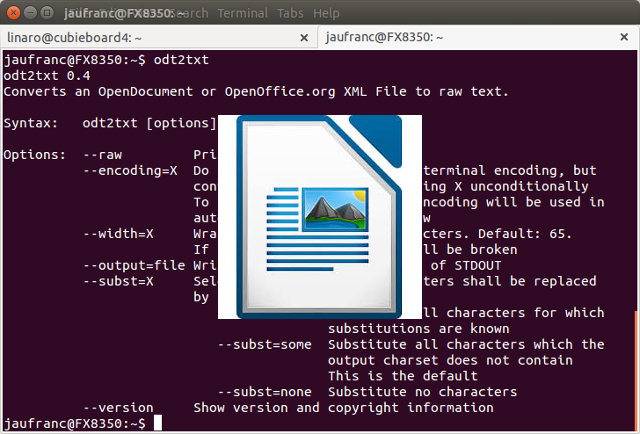Alldocube is a Chinese company known for its Cube Android tablets, and more recently, it has launched some Windows 8.1 tablets. The company has now announced its first Ubuntu tablet with Cube i7-CM featuring a recent low power Broadwell-Y Core M-5Y10 processor. Cube i7-CM tablet specifications: SoC – Intel Core M-5Y10 dual core / four threads processor @ 800 MHz (Burst freq: 2.0 GHz) with 4MB cache, and Intel HD graphics 5300 (4.5W TDP) System Memory – 4GB RAM Storage – 64GB eMMC + micro SD card slot (up to 32GB) Display – 11.6″ capacitive touchscreen; resolution: 1920×1080; 10-point touch. Video Output – micro HDMI Audio – 3.5mm headphone jack, dual speaker, microphone, and HDMI Connectivity – Wi-Fi 802.11 b/g/n + Bluetooth 4.0 Cellular (Data only, single SIM card slot) 4G – FDD-LTE Band 1/3/7 & TDD-LTE 38/39/40/41 3G – WCDMA:900/2100MHz 2G – GSM:850/900/1800/1900MHz Camera – 5MP Rear camera, 2MP front-facing camera […]
ESP8266 Wi-Fi Module is Now Supported in Arduino IDE
ESP8266 revolutionized the IoT world by offering an ultra low cost Wi-Fi solution either standalone or connected to a micro-controller board via SPI or UART. There are plenty of tutorials on the web to play with the Wi-Fi module, but it’s only recently an Arduino IDE has added support for ESP8266. If you want to try it, you can download the binary for Linux, Windows, or Mac OS X. Since my computer is running Ubuntu 14.04, I download and extracted arduino-1.6.1-linux64.tar.xz to install it in my PC. Now simply run the arduino script to start the IDE, and select to Tools->Board->Generic ESP8266 board. I don’t own an ESP8266 module myself, but Olimex tried it on their ESP8266-EVB: They connected a serial debug board and selected Tools->Port->/dev/ttyUSB0 in the IDE Selected Tools-> Programmer->esptool Loaded Blink example, and modified it to turn on and off the relay on their evaluation board. If […]
Kodi 14.2 Final and Kodi 15 Alpha 2 Released
Kodi developers have recently announced two release for Kodi: the stable version of Kodi 14.2 Helix, which should be the last Kodi 14 release, and Kodi 15 Alpha 2 Isengard with some interesting new features. Since Kodi 14.2 is a minor release, no new features have been added, but they fixed several bugs: Application stopped responding on Windows Gap-less playback on MP3 Playback of rtmp protocol Scanning of newly added episodes Fix multipath source scanning Loading external subtitles in some cases packaging of PIL module on Android. This fixes some script error when using weather add-on Fix video playback on all platform after refresh rate change Various bugs that were present in PVR add-ons. Save weather location Fix filtering of foreign add-ons ftps handling Use LastWrite instead of ChangeTime for file system on Windows As usual, you can download the release via Kodi download page for Windows, Linux. Mac OS […]
Scaleway Provides Dedicated ARM Servers for 10 Euros per Month, 0.02 Euro per Hour
Earlier this year, Online Labs launched a beta hosting program using custom-designed C1 dedicated servers powered by Marvell Armada 370/XP quad core processor. The company has now launched a commercial service called Scaleway providing hosting service on these baremetal servers for 9.99 Euros per month, or 0.02 Euro per hour, as well as a “Infinite Storage” service with 1GB data for 0.02 Euros per month. Here are the details of the 10 Euros plan: Server based on Marvell Armada 370/XP quad core ARMv7 processor Memory – 2GB Memory Storage – 50GB SSD Disk 1x Reserved public IPv4 200Mbit/s – Unmetered bandwith Operating Systems – Ubuntu, Debian, Fedora, ArchLinux ARM. Docker supported. That’s not a VPS, but a dedicated server. For reference, I currently pay around $20 per month (Linode) for a server with an Intel Xeon E5-2680 dual core processor with 2 GB RAM and 50 GB SSD storage, and 3 […]
ActDuino S500 Development Board Features Actions Semi S500 Quad Core Processor
Actions Technology is a subsidiary of Actions Semiconductor SoC vendor, that makes solutions based on Actions Semi SoCs, and recently joined Linaro. The company is said to focus on “focuses on solutions for smart handheld and smart home devices. Its main products are tablet, over-the-Top (“OTT”) set-top boxes and Bluetooth enabled boombox solutions, along with total product and technology solutions based on the Android platform”. We already know it will soon release a 96Boards compliant board, but in the meantime, the company has officially launched Actduino S500 development board powered by a new S500 quad core Cortex A9 processor. I actually found out about this board on ARMDevices.net last October, and sent an email asking for information to the company, but I have not received an email yet after 6 months… At the time, the processor was called ATM7059, but now it’s S500, and it’s unclear if they just renamed […]
Allwinner V3 SoC Targets 1080p60 Action Cameras, Supports Linux or Camdroid OS
I’ve previously written about Allwinner V10 and V15 SoC for video applications such as cameras, digital video recorder, and so on. So far, I’ve not found devices based on these, but Allwinner already announced another V-series processor with Allwinner V3 designed for Action camera recording up to 1080p resolution at 70 frames per second. Key specifications are listed below: CPU – ARM Cortex-A7 @1.2GHz Memory 16-bit DDR3/LPDDR3/DDR3L SDRAM controller, up to 1333Mbps 16-bit DDR2 up to 800Mbps, 16-bit LPDDR2 up to 1066Mbps up to 2GB RAM Video / Picture Up to 1080p@60fps or 2-channel 1080p@30fps H.264 video encoding 8M JPEG encoding H.264 1080p@60fps decoding, MJPEG 1080@30fps decoding Integrated ISP up to 8M pixels (HawkView ISP) 2 channel outputs for display and encoding respectively Supports various input and output formats Supports AE/AF/AWB Saturation adjustment, 2D/3D noise reduction, defect pixel correction, and distortion correction Audio Codec Integrated 92dB audio codec 2x ADC […]
Cubieboard 4 Ubuntu Review – Setup, Usability, and Performance
Cubieboard4 is a development board powered by Allwinner A80 octa-core processor with 2GB RAM and 16GB eMMC. I’ve already shown how to get started with the board using the pre-installed Android 4.4 image, and run some benchmarks in Android, so now it’s time to check out the Ubuntu Linaro 14.04 image provided by CubieTech. I’ll show how to install and setup Ubuntu 14.04 on the board using a micro SD card, run desktop applications like Chromium, Libre Office, and son on on the board, and complete the review with some Linux benchmarks. Setting up Ubuntu on Cubieboard4 Firmware images for Cubiebord4 can be downloaded @ http://dl.cubieboard.org/model/cc-a80/Image/. Currently Android 4.4, Debian server, Ubuntu Linaro server, and Ubuntu Linaro desktop with LXDE desktop environment. That’s the latter I’ll use for the experiment, and two images are available: linaro-desktop-cb4-card-hdmi-v0.4.img.7z – Bootable image from micro SD card linaro-desktop-cb4-emmc-hdmi-v0.4.img.7z – Installation image to eMMC to […]
How to Read OpenOffice / LibreOffice Files from the Command Line
Let’s say you have edited a file in LibreOffice Writer, but later you access your computer remotely via SSH for example. You don’t really want to bother copying the file to your current machine, and rather just quickly check its content in the terminal. Is there a way? Since odt files are just some zip files containing XML files, you could manually decompress the file, and open XML files, but there is a more convenient the program is called odt2txt. On an Ubuntu / Debian machine it can be installed with:
|
1 |
sudo apt-get install odt2txt |
For basic usage, you just need to pass the filename as parameter:
|
1 2 3 |
odt2txt test.odt This is a test |
But there are also a few more options:
|
1 2 3 4 5 6 7 8 9 10 11 12 13 14 15 16 17 18 19 20 21 22 23 |
odt2txt odt2txt 0.4 Converts an OpenDocument or OpenOffice.org XML File to raw text. Syntax: odt2txt [options] filename Options: --raw Print raw XML --encoding=X Do not try to autodetect the terminal encoding, but convert the document to encoding X unconditionally To find out, which terminal encoding will be used in auto mode, use --encoding=show --width=X Wrap text lines after X characters. Default: 65. If set to -1 then no lines will be broken --output=file Write output to file, instead of STDOUT --subst=X Select which non-ascii characters shall be replaced by ascii look-a-likes: --subst=all Substitute all characters for which substitutions are known --subst=some Substitute all characters which the output charset does not contain This is the default --subst=none Substitute no characters --version Show version and copyright information |
This also wrote with ods (spreadsheets) and odp (presentations) files with ods2txt and odp2txt which are just symlinks pointing to the same program as odt2txt, namely odt2txt.odt2txt. Jean-Luc Aufranc (CNXSoft)Jean-Luc started CNX Software in 2010 as […]

